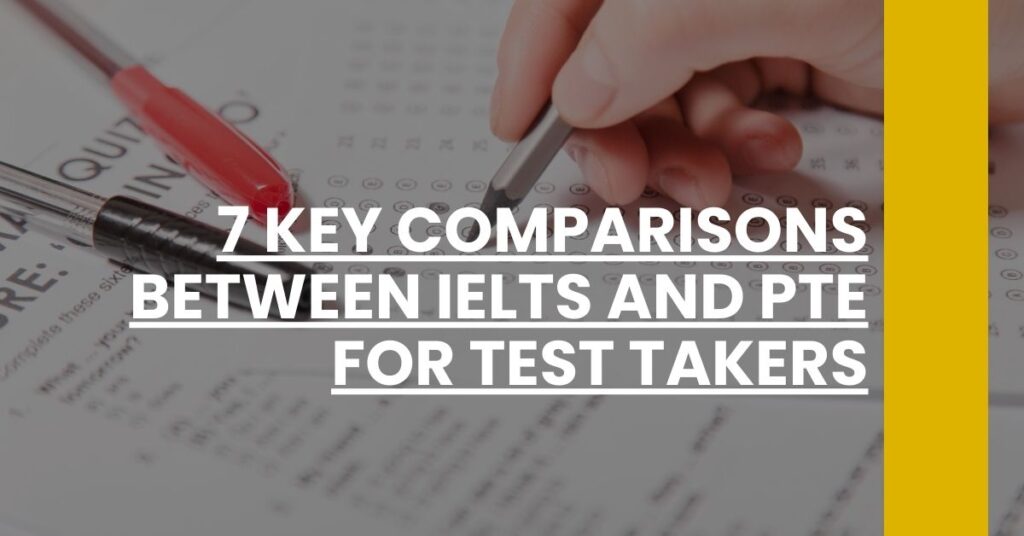When it comes to choosing between IELTS and PTE, it’s important to understand the differences between the two tests.
IELTS, or the International English Language Testing System, is a widely recognized exam that assesses your English language skills in four areas: listening, reading, writing, and speaking. It is accepted by over 10,000 organizations worldwide, including universities, immigration authorities, and employers.
PTE, or the Pearson Test of English, is another popular English proficiency test that evaluates your language skills through similar sections: speaking, writing, reading, and listening. PTE is also widely accepted by universities and immigration authorities, but it may not be as recognized as IELTS in certain regions or industries.
One of the key differences between IELTS and PTE lies in their exam formats. IELTS is a paper-based test, meaning you will be given a physical booklet to write your answers in. PTE, on the other hand, is a computer-based test, where you will use a computer to complete the exam.
Scoring systems also differ between the two tests. IELTS uses a band score system, ranging from 0 to 9, with half-point increments. Each section is scored individually, and then an overall band score is given. PTE, on the other hand, uses a points-based system, ranging from 10 to 90, with 10-point increments. Similar to IELTS, each section is scored separately, and then an overall score is provided.
When it comes to preparation, both tests require practice and familiarity with the exam format. There are numerous resources available, including study materials, practice tests, and online courses, to help you prepare for both IELTS and PTE.
Ultimately, the choice between IELTS and PTE depends on your specific goals and preferences. Consider factors such as the recognition of the test in your target country or industry, the format of the exam, and your comfort level with computer-based tests. Researching and understanding these factors will help you make an informed decision and select the test that best suits your needs.
- 1. Overview of IELTS and PTE
- 2. Exam Structure and Format
- 3. Scoring System and Results
- 4. Test Preparation Requirements
- 5. Test Difficulty Perception
- 6. Cost Comparison and Affordability
- 7. Global Recognition and Acceptance
- English Proficiency Levels and CEFR Comparisons
- Test Location and Availability
- Test-Taking Experience: Offline vs. Online
- Conclusion: Making an Informed Decision
1. Overview of IELTS and PTE
When you’re gearing up for an English Language Proficiency test, understanding the nuances between the International English Language Testing System (IELTS) and the Pearson Test of English (PTE) is imperative. Both IELTS and PTE stand as pillars of language assessment, gateways to education and professional opportunities across the globe.
IELTS has been a longstanding measure of English proficiency, accepted by numerous universities, employers, and immigration authorities. Rooted in traditional methodologies, it has adapted over time, now offering both paper-based and computer-delivered tests to align with varied preferences.
PTE, comparatively newer, is fully computerized and prides itself on fast result turnaround. It’s recognized by an array of academic institutions and professional bodies, particularly in Australia and New Zealand, and is gaining ground for immigration purposes.
Before diving into IELTS vs PTE, it’s essential to acknowledge that both tests are rigorous and reputable pathways to showcase your command over the English language.
2. Exam Structure and Format
Let’s unpack the structure to help you make an informed decision:
IELTS
- Listening: 30 minutes, four sections ranging from conversations to monologues.
- Reading: 60 minutes, comprising various question types like multiple-choice and match the headings.
- Writing: 60 minutes, includes task 1 (report writing or letter writing) and task 2 (essay).
- Speaking: 11-14 minutes, involves a face-to-face interview with an examiner.
PTE
- Speaking & Writing: Combined into one section lasting around 77-93 minutes.
- Reading: 32-41 minutes, with a variety of item types such as re-order paragraphs and reading comprehension.
- Listening: 45-57 minutes, comprising summarizing spoken text and multiple-choice questions.
As you can see, IELTS provides a more segmented approach to testing your abilities, while PTE combines elements, requiring you to switch gears quickly.
3. Scoring System and Results
The moment of truth in any test is the score, and here’s where IELTS and PTE diverge distinctively.
- IELTS: Adopts a Band Score system from 0-9, in half-band increments. Your performance is scaled across all four parts to give an overall band score. For a deeper dive into how scores are calculated, consider the comprehensive grading scales.
- PTE: Uses an algorithmic scoring system with a range from 10 to 90, which reflects both overall English proficiency and performance on communicative skills and enabling skills.
Understanding these scores is paramount, as they often directly correlate to university admission criteria or visa requirements.
4. Test Preparation Requirements
You might be considering which test aligns better with your existing skills. Here’s some food for thought regarding preparation:
- IELTS necessitates a strong grasp of English across all four skills, with a significant emphasis on the ability to produce coherent written pieces and fluent spoken responses.
- PTE demands comfort with a digital environment, rewarding those who can articulate their ideas directly and succinctly.
Tailoring your preparation to suit the test format is crucial. Whether through self-study using available resources or structured classes, ensure that you focus on tasks that mimic the test conditions.
5. Test Difficulty Perception
The notion of difficulty is subjective and varies from one individual to another. However, when pitting IELTS vs PTE, certain trends emerge:
- IELTS often feels more approachable for those who prefer conventional exam settings and direct interaction during the speaking test.
- PTE’s digital format can either intimidate or invigorate you, depending on your proficiency with computers and typing.
While some argue that the PTE’s automated scoring removes human error, others feel the IELTS offers a chance to connect personally with examiners. Consider which scenario plays to your strengths and weigh that against the perceived difficulty reported by other test-takers, as detailed in experiences shared on educational forums.
6. Cost Comparison and Affordability
When cost enters the equation in the IELTS vs PTE deliberation, your wallet deserves a say. Grasping the exam fees and potential additional expenses is smart before committing to either test.
- IELTS: The exam fee isn’t a flat rate globally; it varies by country. For example, in India, the fee ranges around INR 17,000. But beyond the test fee, consider costs for preparation materials, potential travel expenses to test centers, and if you’re doubling down on preparation courses.
- PTE: On the financial scale, PTE offers a competitive edge with a slightly lower fee of INR 15,900 in India, inclusive of Goods and Services Tax. Factor in the possibility of retake fees and similar auxiliary costs as IELTS.
Choosing between IELTS and PTE on cost alone may not be prudent, but it’s definitely a tangible factor for your consideration.
7. Global Recognition and Acceptance
The global footprint of your English test is significant. An impressive score is only as good as the number of doors it opens.
- IELTS: With an established track record, IELTS is a giant with an acceptance credential that spans over 11,000 entities globally, from academic institutions to government bodies.
- PTE: It’s making strides, especially in specific corridors such as Australia, yet in some locales and fields, it might not carry the same weight.
Before taking a leap, confirm the test recognition that aligns with your endeavors. After all, the true worth of these exams is where they can take you.
English Proficiency Levels and CEFR Comparisons
In navigating the IELTS vs PTE choice, consider how they map onto the Common European Framework of Reference for Languages, or CEFR.
- IELTS: A band score of 7, for instance, signifies a strong command of English, comparable to CEFR’s B2 level.
- PTE: A score of 65-75 reflects similar competency, also aligned with B2.
This comparison can serve as a linguistic compass for the recognition and comprehension of your test scores in broader educational and professional contexts.
Test Location and Availability
Accessibility is key, and the availability of test centers plays a vital part in your planning and logistics.
- IELTS: Boasting an impressive network of over 1,600 test locations in 140 countries, IELTS ensures you’re likely to find a venue within reasonable reach.
- PTE: Not to be outshone, PTE offers hundreds of centers around the globe, with strategic placement in urban locales.
It’s important to evaluate test center locations in conjunction with the frequency of test dates to schedule a sitting that’s convenient for you.
Test-Taking Experience: Offline vs. Online
Your comfort level with the testing medium can significantly affect your performance.
- IELTS: Offers the choice between the familiarity of pen and paper or the precision of a computer in certain countries.
- PTE: Embraces the digital age with a solely computer-based format.
Choosing the medium that resonates with your test-taking persona can have a surprising impact on your outcome. Glean insights from fellow test-takers who’ve navigated both offline and online experiences and consider your own comfort with technology.
Conclusion: Making an Informed Decision
As you stand at the crossroads of IELTS vs PTE, the optimal path is personal and as unique as your academic and professional story. Your decision hinges on a blend of factors: test format, scoring style, preparation plans, financial considerations, and recognition of the test score in your desired destination.
Remember, this isn’t a one-size-fits-all scenario. You’re best served by an honest assessment of your strengths, learning style, and end-goal requirements. Whether you opt for the tactile pages of IELTS or the digital domain of PTE, ensure your choice amplifies your potential for success.
The key to conquering the English proficiency test battlefield is to align your battle gear—be it the traditional armor of IELTS or the techy toolkit of PTE—with your quest’s unique demands. Above all, stride into your chosen arena with confidence and the reassurance that you’ve made an informed, strategic decision in your IELTS vs PTE journey.
IELTS vs PTE: Compare key differences, scoring, format to choose the best English proficiency test for your academic or migration needs.

